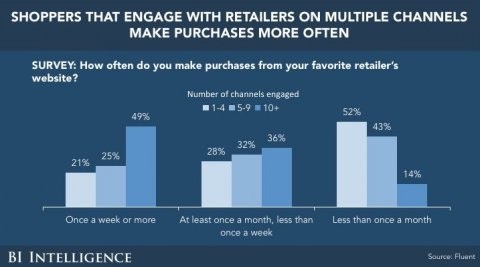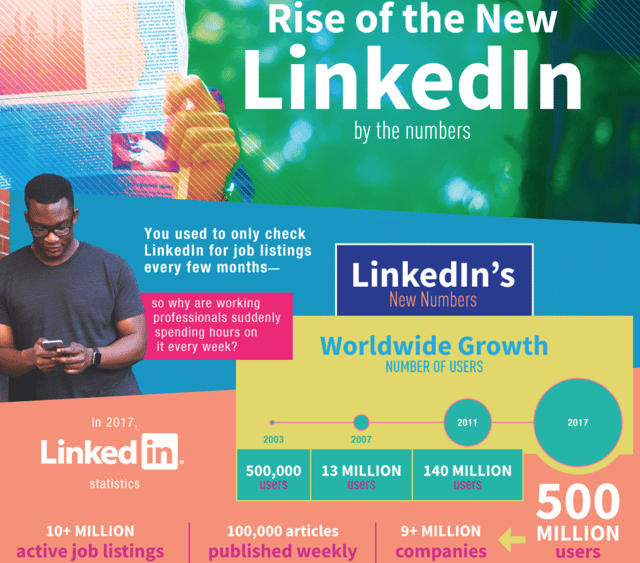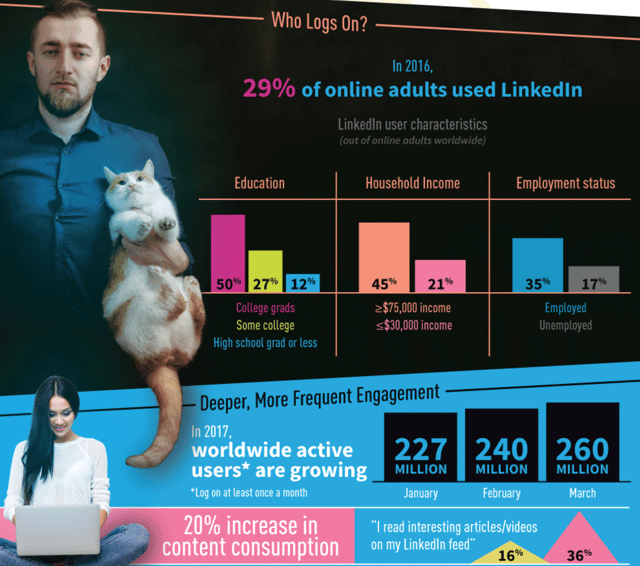Selling your outdoor products and building your outdoor brand isn’t going to be multi-channel, it is multi-channel now. The change in consumer behaiior and the channels that can be used to conduct sales is evolving as you read this article. While you navigate the changing relationship with your traditional dealer network, you have embraced the need to execute a social selling strategy. However, the social platforms available have very different demographics and focus on the individuals engaged with them. If you are after a higher end, brand loyal demographic that will pay for quality, brand purpose and in the B2C space, then maybe it’s time to task internal or external resources to fully take advantage of the opportunities LinkedIn (LI) is providing outdoor digital marketing.

New data is emerging that demonstrates the importance of an outdoor industry brand marketing its products across multiple channels. A multi-channel strategy is delivering sales. A Fluent survey found that 47% of shoppers who engage with retailers across 10 or more channels make purchases from their favorite retailer's website at least once a week, compared to just 21% for those who engage across one to four channels.
And social is becoming increasingly important, as Epsilon found that retailers' social channels led 29% of US shoppers to try a new brand or product. That figure was 28% for brands' social media and 22% for consumers' friends' social media.
Customers expect convenience and a variety of options when making a purchase. Brick and mortars must be able to seamlessly carry the experience online, through social, and on mobile. Even online giants like Amazon are experimenting with physical locations in order to accommodate their customers in a multitude of ways.
The bottom line: It's not physical or digital-it's physical with digital.
So are you engaging your potential B2C customers across multiple channels, including LinkedIn? (Click here to see practical ideas and pro-tips on how to use LI in your outdoor industry B2C marketing strategy)
Everywhere you look and listen, a disproportionate amount of discussion among outdoor brand managers is engaging and connecting with “millennials.” Yes, they are a big purchasing segment whose oldest members now have money to spend and the desire to “experience” life’s adventures, whether it’s eating out or participating in some type of outdoor activity. However, it is worth being fully aware that this group also is part of the great “Amazon nation.” It’s not without some irony that it was recently observed in an SGB posting that,
“Brands prefer to build a strong brand experience through their own sites to convey the brand DNA. The Amazon experience is about convenience, not the emotional connection. And the younger shopper is looking for brands on the cheap. Brands asking how they can deliver content the way Amazon does should consider this model.” (emphasis added)
LinkedIn Today: A Viable Marketing Channel for Your B2C Outdoors Industry Brand
Historically LinkedIn has been viewed as a superior B2B source of business leads and sale conversion opportunities with Facebook and Instagram the darling for B2C. However, the lines between what works for B2B and B2C seem to be blurring.
What Are You Missing?
Taking a page from many of the outdoor brands I monitor, a critical message in positioning products is “it’s about readiness". One can plan and plan and plan for their outdoor adventures but no amount of planning can prepare you for the changes likely to come. Your gear has to be ready to "perform.”
Similarly, you plan and plan and execute your social selling strategy based on the best intelligence, but,
“no product launch, project plan, or program ever goes exactly according to your original plan. If you’re shifting and moving appropriately with the market, it shouldn’t remain exactly to the original plan. It’s really important to assess, reassess, and pivot where necessary.”
Are you ready to pivot where necessary?
It's Not About Whether LinkedIn Has Millennials, It's About The Overall Demographics of LinkedIn
Yes LI has millennials, about 38% of their entire user base is in this category. But rather than obsess over just the millennial segment, it's time to take a much closer look at the overall demographics of LI subscribers. ComScore has published some insightful research that demonstrates the power this population holds for outdoor industry brands for developing a B2C strategy.
- LinkedIn members are loyal brand advocates, willing to pay more for a brand they relate to. Eighty-six percent said, “When I find a brand I like, I stick to it.”
- According to comScore’s 2013 Buying Power Index, LinkedIn members have nearly 2x more buying power than Facebook.
- Members are more than 2x more likely to trust information provided on LinkedIn than other social networks, which drives purchases.
- Behind every business is a collection of consumers that have a favorite outdoor interest and brands
- LinkedIn members are 93% more likely to have a college degree than the average online adult, fitting part of the 20% high spend consumers in outdoor gear
Additionally, recently, Buffer posted a terrific podcast that listed some of the more intriguing LinkedIn user demographics. They were:
- Twenty-nine percent of online adults use LinkedIn
- Fifty-six percent of users are male and 44 percent are female
- Fifty-one percent of users have a college degree
- Thirteen percent of millennials (15 to 34-year-olds) use LinkedIn
- Forty-four percent of users earn more than $75,000 a year
- Forty-one percent of millionaires use LinkedIn


Casting a wide net too often lands you in the "me too" category, and you get lost in the noise. Selling your products on the channels that enable brand value is critical
Are you willing to set your brand apart in social selling strategy? If so, do you want to be set apart where others are not and doing so in one of the fastest growing social selling segments? In just the last six years, LinkedIn has grown its user base from 116 million to 500 million.
Pivoting to Making LinkedIn a Major Social Selling Platform for Your Outdoor Brand
It's time to start a plan to truly engage in the LI space. While others are still treading in the other larger social pools to drive B2C e-Commerce sales for their products, there is a smaller, but more powerful channel you should be using: LinkedIn
Here are the key LinkedIn methods available and the tools to use for success on this platform.
Networking to Build Personal Branding
As Buffer noted, "Ultimately, LinkedIn’s biggest value proposition and its reason for growth lie in the ability for members to develop a strong personal brand."
- Seventy-nine percent of professionals say that networking is valuable for career growth
- Sixty-one percent of professionals say that regular online interactions with networks can lead to job opportunities"
For an outdoor industry company, what does this really mean to you in developing a B2C strategy? Sure the average CEO on LI has 930 connections, but it's so much more than just the head of the company or the other C suite level people in your outdoor industry company. You want these folks to create content that tells about their products and uses, about how they go about developing new products, about how they use new materials and technology, about how their products improve the lives and experiences of those who use them, about the "purposes" and causes they are connected, about the people who work at the company, etc.
Original creative content by these company leaders then becomes stories and causes the employees can use, which means you need to get your employees on LinkedIn.
When brands have employees that feel empowered to build their own brand and network with others outside of their traditional work, it’s a win-win for both the individual and the brand. This can include listing and sharing insightful information about their outdoor hobbies, causes, and professional organizations.
You and your employees having creative hobbies have been shown to make people more helpful, collaborative, and creative in their job performance. This also translates to how they grow and interact on LinkedIn.
For each employee you have building their own brand on LinkedIn they are also building your company brand and laying a foundation for sharing information that can be used by others to connect and purchase from your company. For example, employees can share product reviews to create social proof. Social proof is igniting herd mentality in your prospective buyers. Amazon uses this effectively by featuring reviews prominently on product pages. Encourage them to be on LinkedIn and train them how to leverage those connections.
Connect With Top Product Prospects: Use LI targeted Ads Just As Effectively As You Have Done On Other Social Platforms
Within the 500 million members of LinkedIn are potential customers you can now target by using very discreet data to identify the right audience. LI has significantly increased the depth and breadth of its advertising targeting tools and filters. Use these data-rich targeting tools to gain the high-quality engagement you’re looking for. Sponsored posts offer the opportunity for brands to target based on educational institution, interests, and other factors to get more valuable clicks per post.
Luxury and lifestyle brands or brands with high-end products have the ability to target the exact customer they’re looking for all on one platform. For example, Callaway, a high-end golf brand, launched a LinkedIn advertising campaign prior to the 2013 U.S. Open. Its goal was to re-energize their brand presence among digitally-connected professionals who golf and to take advantage of the sport’s value for networking to build deeper relationships with customers. Callaway developed “Hit the Links,” an interactive app that let LinkedIn members create their “ultimate foursome” using their own network connections. In the end, they reached 8,270 foursomes created, 1,500 new followers for Callaway Golf Company Page, and 83% lift in positive sentiment on social networks.
Publish Content and Especially Use the Video Tool
On August 22, 2017, LinkedIn launched what might be their biggest update since Pulse – native LinkedIn video. Not long after its launch, information was released by LI that would indicate their videos are doing quite well. Initial videos from the launch are getting shared 20+ times more than any other content.”
Besides the new video tool is the improved written publication tool. Here's what my friend Viveka von Rosen, one of the world's top experts on LinkedIn has to say about the content publisher on LI.
"This is a feature far too few users on LinkedIn actually use, especially for B2C. However, that is good for you because it will help your content stand out from the competition. You may be surprised as to how much content you may publish on LinkedIn. Publishing content on LinkedIn gives you access to a host of advantages. First, it keeps your profile constantly in front of connections. Once you publish it will show up on their timelines. The content can prove insightful and answer vital questions a client may have about your business. Your published content can also attract new connections who may never have found your profile otherwise. There really is no reason why you shouldn’t publish content to LinkedIn. It is easy, you’re likely already publishing content to other social media accounts, and you’ll reap the rewards from doing so."
It’s working, too! More than 100,000 organic articles are published weekly on LinkedIn, many of which are written by top-level executives at brands around the world. Here are five examples of B2C companies "killing it" using the written publishing platform.
Some Practical Ideas and Pro-Tips on How To Use LI in Your Outdoor Industry B2C Marketing Strategy
Viveka von Rosen and I have teamed up on a four-part video series that will be published on The Digital Outdoorsman on “Why and How to Build a Winning B2C Strategy for Outdoor Brands on LinkedIn.” Prior to its release, here are some of our practical ideas and pro-tips to consider in developing your outdoor industry B2C marketing strategy.
1. Develop a time-sensitive campaign that invites targeted personas to follow a page about planning a camping weekend for the family. Have a quiz for them to take about “what makes for a fun and memorable family camping experience.” Provide how-to links, personal story links, images, video to inspire, allow them to enter a contest to win your company’s products that contribute to creating such experience. The purpose is to encourage potential customers to find out more about the business and highlighting useful content from around the web.
2. Women and the Outdoors- Getting Out There Gets You There. Build a series of posts that capitalize on growing interest of women to experience and participate in the outdoors. Specific information on how to start in certain outdoor sports, equipment for women and why it matters on making the experience more enjoyable. Role of outdoors in empowering women in their career and personal life. (This fits well with fact the majority of LinkedIn users use the platform for professional development and job searches)
3. Use a company’s LI page to give insight into the human faces and policies behind their consumer culture. Millennials expect companies to have a cause, a purpose from which to build brand loyalty.
4. Use a company page to tease out new product releases, product videos, and snippets of ambassador stories, reactions. Pull the engagement lever by providing a place for fans to discuss their reactions to new products.
Check out Viveka's presentation, "4 Steps to Creating Explosive Success with Content Marketing on LinkedIn" at Inbound 2017 by clicking on the button below.
Where Do You Go From Here?
It looks to Viveka, myself and others that 2018 will be an amazing year for LinkedIn – both as a social media platform and a marketing channel for brands and businesses.
We expect that under the direction of CEO Jeff Weiner LinkedIn will continue its phenomenal growth adding new features, enhancing existing ones and connecting us in a manner very different from other social platforms. LI will create amazing new opportunities for outdoor industry brand marketers to create and nurture connections with a highly desired demographic.
Again, as Buffer noted, "Keep an eye on the growth of written and video content as well as an increased focus on activating influencers by brands within their community."
Creating a strategy for B2C through the LinkedIn platform requires you to plan, assess, reassess, pivot and modify. This means learning to live and embrace being comfortable in the grey space, understanding conditions are likely to change!
Here at The Digital Outdoorsman, we know how critical it is for our clients to be able to keep up with employing cutting edge technology and executing across platforms on a daily basis. We work hard at being technology and platform leaders. We also believe in partnering with other vendors to provide the tools and expertise for outdoor brand companies to succeed in outdoor industry marketing. This is why I have developed a five-part video series with tips from Viveka on how to use LI to sell B2C. Besides this useful series, you can contact her for individualized personal training, company training or participate in one of her LI boot camps.
Here are the links to the four individual video interviews with Viveka covering this topic.
How to Use LinkedIn for B2C Marketing - Pt 1 - Video Series
How to Use LinkedIn for B2C Marketing - Pt 2 - Video Series
How to Use LinkedIn for B2C Marketing - Pt 3 - Video Series
How to Use LinkedIn for B2C Marketing - Pt 4 - Video Series
Get the Outdoor Industry Guide to Digital Marketing

